Vital Signs: Learning Is Alive and Well at Faubion Elementary
Through teamwork and testing, a struggling school bounces back.
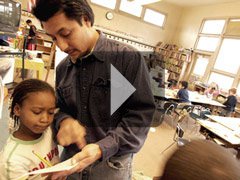
Running Time: 9 min.
On a gray Portland morning, rain drizzles on twelve worn basketball standards outside Faubion Elementary School; only five have rims and none of those has a net. The light blue paint on the building is cracking at kids'-eye level. Inside, there are minimal supplies -- pen and paper in place of PCs, plain whiteboards instead of interactive ones -- and, defiantly, a tightly knit learning community that thrives despite the odds against it.
Faubion is a quiet champion, an institution that has worked its way to the heights of achievement without glamorous gadgets or corporate sponsorships. In the semi-industrial northeast quadrant of Portland, Oregon, where children's home lives are often beset by poverty, drugs, and violence, the staff at Faubion has created a serene school environment in which most students succeed.
Between 2001 and 2005, the number of fifth graders meeting or exceeding state benchmarks on the Oregon Statewide Assessment jumped from 66 percent to 90 percent in reading, and from 71 percent to 92 percent in math. The school is narrowing the gap in reading and math scores between students who are eligible for free or reduced-cost lunch (76 percent of the population) and those who are not. And walking through the building, visitors can see children engaging with their work, and often hear a surprising sound -- silence.
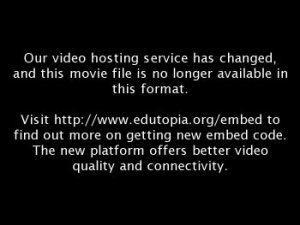
Rather than invest heavily in a single initiative, the K-6 school has achieved its success through a combination of less dramatic programs, all of them centered on aiding the individual student. At their core, these efforts include a devotion to assessment as the compass for instruction, and the conviction that teachers, like students, must constantly strive to better themselves with help from a community of peers.
"It feels good to come here," says Leslie Rennie-Hill, director of program initiatives at the Portland Schools Foundation, which recently honored Faubion with its Excellence in Education Award for raising achievement among at-risk groups. Nearly three-fourths of students here identify themselves as members of a racial minority (most of those are African Americans), and 12 percent are learning English as a second language. Rennie-Hill adds, "They're focused on the right thing."
Adults at Faubion have a mantra -- "Every child can achieve" -- that's become almost mundane in the No Child Left Behind age, but educators here walk the walk, and assessment is their crucial tool. Three times a year, teachers give students a battery of tests, evaluating strengths and weaknesses in math problem solving, math content, writing, and reading. Most of the measures were created by the Portland Public Schools, but teachers also use the Pearson Learning Group's Developmental Reading Assessment and consider results of the annual Oregon Statewide Assessment.
Taking all the data together, the staff gathers to pinpoint the individual needs of 314 students and clusters children into working groups based on their particular areas of weakness. They might determine, for example, that one child needs extra support in math through Title I, while several others who struggle with the letter r could use small-group work on phonics.
"We'll create whatever it is the assessments show us they need," says Mary Harbolt, who teaches fourth grade. No student is locked into the same group all year; between assessment periods, teachers keep watch on children's learning and shuffle their placement in response to progress.
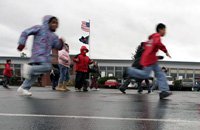
This personalization of instruction plays out daily in Harbolt's class, which she team teaches with Gayle Quigley. It's the only team-taught class in the school (by Harbolt and Quigley's own choice), comprising the entire fourth grade.
On one recent morning, Quigley took a group of thirteen students into a separate room and leveled with them about their purpose: The separate reading groups were for children who needed help with different things. "Some students need help with comprehension, understanding what they read," she said. "Some students need help with inference, reading between the lines."
The target skill for this group on this day was understanding context. In groups of three, the kids used context to fill blanks in a story, "The Great Toothpaste Plot," haggling over the proper word to complete each sentence. Simultaneously, next door, student teacher Anna Lail was quizzing students for comprehension of the book Sarah, Plain and Tall, by Patricia McLachlan, which they had read over the course of a few weeks and used in vocabulary lessons.
Achieving this precision of instruction requires a heavy time investment -- Harbolt estimates that it can take up to a month for everyone in the school to complete each round of assessment -- but teachers say it's worth it.
"It took us a long time to get over the fact that we kind of shut down when we do these assessments, because you start thinking, 'Oh, my gosh, we're losing instructional time,'" Harbolt says. "But in the long run, once we really embraced the assessments,we realized that it made our instruction so much more focused that the time lost wasn't an issue. Once you know where that child is performing and once you have the opportunity to start teaching them what they need to learn, they can really blossom." She adds that making students active players in that process, explaining to them that she doesn't want to waste their time teaching them what they already know, strongly drives them to perform.
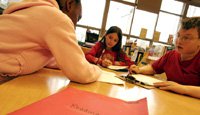
Though a focus on achievement permeates the school, teachers do nurture children's social and intellectual development, not just their test scores. The Portland Schools Foundation's Leslie Rennie-Hill explains, "What they're teaching to here is strong literacy and strong math, and it just works out that they're doing well on the test."
Intimately linked with Faubion's assessment program is its culture of professional development and collaboration. For two hours every other Monday afternoon, the staff meets to tackle one in a rotating list of topics: math, reading, writing, and life-skills education. They use the time to assess data, develop curriculum, discuss the needs of individual students, and participate in professional-development workshops -- sessions often led by Faubion teachers who have completed outside training on particular skills.
The key to this training is that teachers choose what they want to learn; each year, they agree on one weak area to give particular emphasis (this year, writing), and it's typically the area where test results show students need the most help. As Harbolt says, "We figure if they're weak on it, we must be weak on it."
Even outside the Monday meetings, a spirit of teamwork thrives. Many staffers literally teach with their doors open, and they comfortably call on each other for help with discipline or instruction during class. The schedule is arranged so that teachers within the same grade level share prep periods, and they use that time to collaborate and plan. This milieu engenders loyalty; over the course of five years, only two teachers have left -- one on medical leave and one to retire.
"We have built this sense that we're all in this together, and we want to see scores go up, and we all believe that every kid can learn," says Susan Corey, a kindergarten teacher at Faubion for eight years. "I feel confident enough that I could walk into anyone's classroom unannounced and they would welcome me."
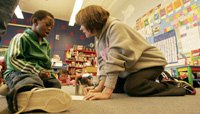
Creating this culture was hard. Jackie Davis, a Title I teacher who has worked at Faubion for twenty-five years, remembers the disruption a decade ago when an administrator mandated weekly in-service sessions for Title I teachers in northeast Portland to develop assessments and weave them into schoolwide practice. The Faubion principal at the time embraced the changes and built on them by nurturing teacher collaboration. Quigley recalls that the transition was tough, and educators who couldn't adapt didn't stay. "That was really the impetus that made people say, 'Wow, we need to look at where kids are and where we need them to be, and make a plan to get them there,'" Davis says. "We are still reaping the benefits of that one year."
Faubion still has a long road to travel; the two kindergarten classes, severely over-enrolled at twenty-seven and twenty-nine children, are islands of chaos, despite the teachers' dogged efforts. "Your brains, can they get smarter if we can't hear?" is Susan Corey's patient, near-constant refrain to her students. Fellow kindergarten teacher Felipe Lara says the ninety minutes a week of common planning time afforded is barely enough time to breathe, let alone share lessons.
But the teachers' and principal's collaborative approach gives some promise of progress. The fellowship helps Corey and Lara summon the energy daily to teach fifty-six rambunctious five-year-olds between them. It brings together instructors from different grades who struggle to teach siblings from the same distressed families. Furthermore, teamwork and assessment of not only students' performance but also their own poise Faubion educators to keep improving their school -- with or without basketball nets, new paint, or new computers.
Go to "How to Teach Character in the Classroom."